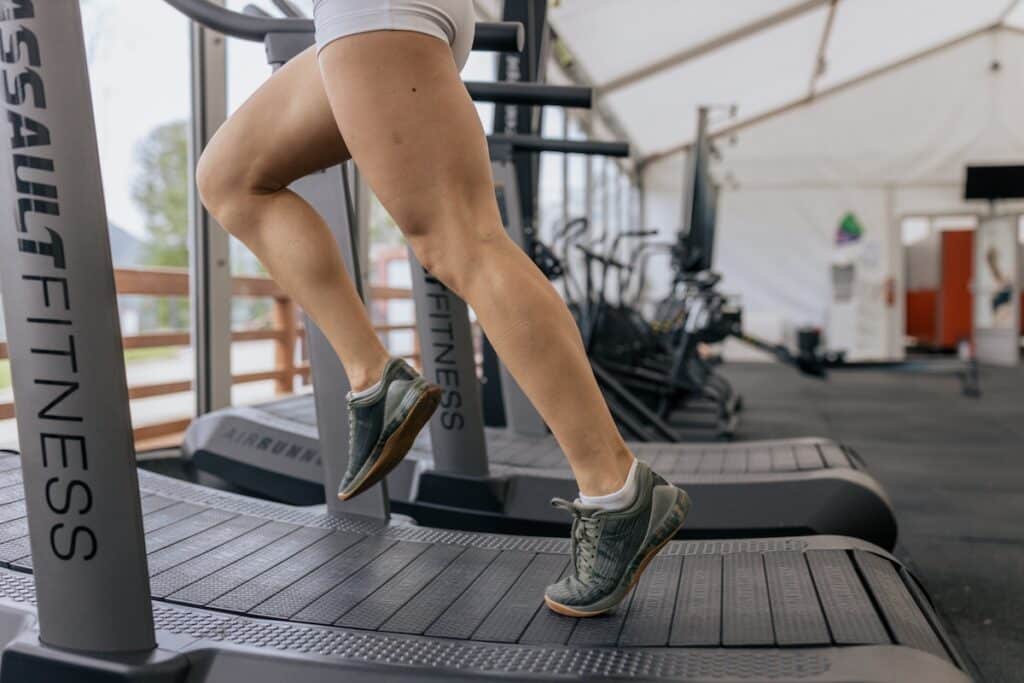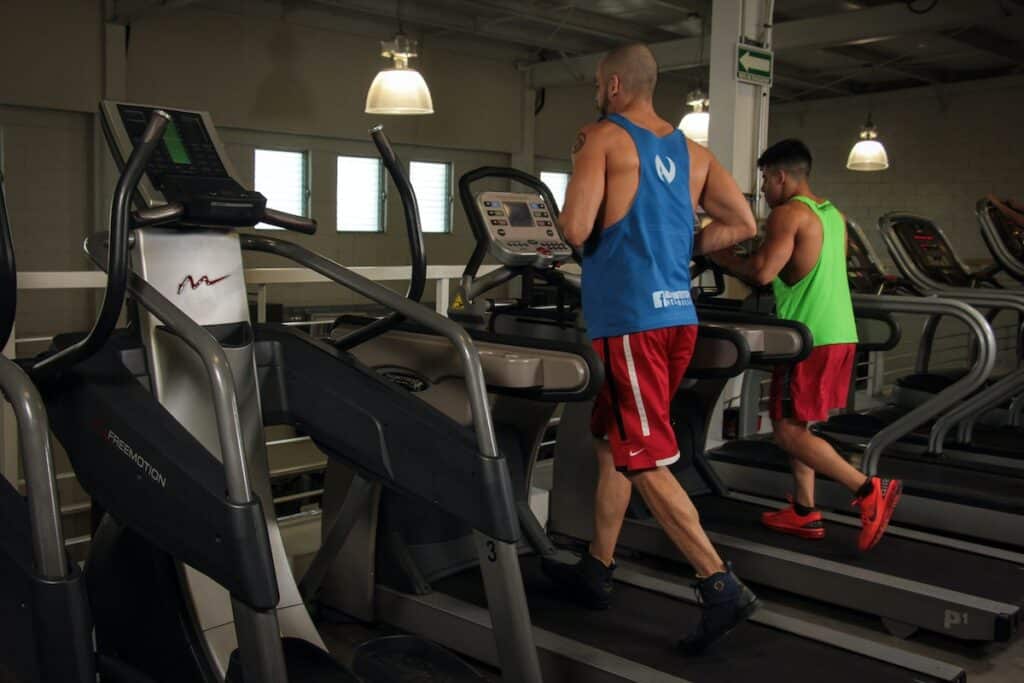
Have you been wondering if treadmills are bad for your knees? Treadmills are easy to use and can give you a controlled workout, making them an appealing choice for workouts. However, knee pain is a common complaint among treadmill users, and this can be due to a variety of factors.
In this article
One of the most common causes of knee pain is patellofemoral pain syndrome (PFPS), also known as “runner’s knee.” This condition is caused by stress on the kneecap and the cartilage underneath it, and it’s often a result of repetitive bending and straightening of the knee.
Another common cause of knee pain is iliotibial band syndrome (ITBS). The iliotibial band is a thick band of tissue that runs from your hip to your shin. If it becomes tight or inflamed, it can cause pain on the outside of your knee.
In this blog post, we’ll delve into the factors contributing to knee pain while using a treadmill and provide tips to prevent injury. So, lace up your running shoes and read on to find out how you can keep your knees healthy while enjoying treadmill workouts.
[Related: How to Lose Weight When You Have Bad Knees]
Are treadmills bad for your knees? No, treadmills are not inherently bad for your knees. However, improper use or pre-existing knee issues may cause discomfort or injury. While some people may experience knee pain on treadmills, others can use them without issue if they follow proper guidelines and injury prevention strategies.
Is running on a treadmill better for the knees than running outside?
Running on a treadmill can be easier on the knees compared to running outside, especially on hard surfaces like concrete or asphalt. Treadmills often have cushioned decks, which can reduce the impact on your joints. However, other factors such as running form, footwear, and incline settings can also influence knee health while using a treadmill.
[Related: Does Running Burn Muscle? (Here’s the Truth)]
To minimize knee stress, it’s essential to maintain proper running form, wear appropriate footwear, and incorporate cross-training and rest days. Additionally, some outdoor running surfaces, such as grass or dirt trails, can be more knee-friendly than running on a treadmill.
What should you consider when using a treadmill?
The impact of using a treadmill on knee health can be both positive and negative, depending on various factors. Here are some points to consider:
1. Treadmill cushioning
Most treadmills have cushioned decks that help absorb some of the impact forces generated during running, potentially reducing stress on the knees compared to running on hard surfaces outdoors.
2. Running form
A poor running form on a treadmill can contribute to knee issues. It’s essential to maintain proper posture, stride length, and footstrike to minimize the risk of knee injuries.
3. Footwear
Wearing inadequate or worn-out footwear while running on a treadmill can lead to knee problems. It’s crucial to select appropriate shoes that provide sufficient support and cushioning.
4. Incline settings
Running on an incline can increase the load on your knees. While moderate incline levels can help build strength and endurance, excessive incline may increase the risk of knee issues.
5. Overuse
Excessive treadmill use without sufficient rest or cross-training can lead to overuse injuries, including knee pain. Like any repetitive activity, running or walking on a treadmill can lead to overuse injuries if you don’t give your body enough time to recover or if you don’t vary your workout routine.
To prevent these and other overuse injuries, it’s important to incorporate rest days into your training schedule and cross-train with other activities. This can help ensure that you’re not always using the same muscles in the same way, which can help prevent injury.

What is a proper running form on a treadmill and why is it important?
Running on a treadmill differs slightly from running outdoors due to the moving belt, but the basic principles of good running form still apply. The first aspect to consider is your posture. Good treadmill running form begins with an upright posture and a forward gaze. Avoid leaning at the waist and keep your neck aligned with your spine. Shoulders should be relaxed and arms should swing at your sides with a 90-degree elbow bend.
In the lower body, maintain a stable torso and forward-facing hips. Aim for a mid-foot strike, as landing on your heel can stress your joints. Avoid overstriding; your foot should land under your hip. Aim for a cadence of 160 to 180 steps per minute, and use a slight incline on the treadmill to mimic outdoor running.
Understanding the significance of correct treadmill running form is crucial for optimizing your workouts and safeguarding against injuries. Here’s why you should follow these tips and maintain a proper form during your treadmill sessions:
1. Reduced risk of injury
A proper running form helps to distribute the impact forces more evenly across your joints, reducing the stress on your muscles and joints. By maintaining proper posture, stride length, and foot strike, you can minimize the risk of injuries, such as knee pain, shin splints, and plantar fasciitis.
2. Improved performance
A good running form ensures that your body is moving efficiently, which can help you conserve energy and improve your overall performance. This allows you to run longer and faster without excessive fatigue.
3. Increased comfort
Running with proper form on a treadmill can make your workout more comfortable and enjoyable. Poor running form can lead to discomfort and may discourage you from continuing your treadmill training.
4. Better transfer to outdoor running
Developing good running form on a treadmill can make it easier to maintain proper form when running outdoors. This can help you avoid injuries and improve your performance when transitioning between treadmill and outdoor running.
5. Targeted muscle engagement
A proper running form on a treadmill can help engage the right muscles and prevent muscle imbalances. By maintaining proper alignment and biomechanics, you can activate the muscles in your core, glutes, and legs more effectively, leading to better overall fitness.
What should you look for in a treadmill if you have knee problems?
If you have knee problems, choosing the right treadmill can help reduce the impact on your joints and minimize the risk of further injury. Here are some key features to look for when selecting a treadmill:
1. Cushioned Deck
A treadmill with a cushioned deck can help absorb impact and reduce stress on the knees. Look for models that offer adjustable cushioning so that you can customize the level of shock absorption to your individual needs.
2. Incline Settings
Treadmills with adjustable incline settings can help simulate outdoor running conditions and build strength in the legs. However, it is essential to use incline settings responsibly and avoid steep inclines that may strain the knees.
[Related: Does Walking on An Incline Burn Belly Fat?]
3. Low-Impact Settings
Some treadmills offer low-impact settings that are designed to minimize the impact on the joints. These settings typically involve reducing the speed and adjusting the incline angle to provide a gentler workout.
4. User Weight Capacity
Make sure to check the user weight capacity of the treadmill, as exceeding the recommended weight limit can place excessive stress on the knees and other joints.
5. Speed and Program Options
Choose a treadmill that offers a variety of speed and program options so that you can customize your workout to your individual needs and fitness goals.
6. Safety Features
Look for treadmills with safety features such as an emergency stop button or safety clip to prevent accidents and injuries.
7. Adjustable Handrails
Some treadmills offer adjustable handrails that can be raised or lowered to accommodate users with different heights and stride lengths. This feature can help promote proper posture and reduce strain on the knees.
Frequently asked questions (FAQ)
Got more questions about the impact treadmills for your knees? Check out some of the most commonly asked questions about this topic below.
What are the potential risks of using a treadmill for knee health?
Using a treadmill can impact knee joints and increase the risk of overuse injuries, especially if proper form and technique are not followed. However, with proper precautions and gradual progression, treadmill use can be safe and effective for promoting knee health.
Can treadmills cause long-term damage to knee joints?
While there is no definitive evidence that treadmill use can cause long-term damage to knee joints, it can exacerbate pre-existing conditions or contribute to overuse injuries if not used properly. It’s important to listen to your body and seek medical advice if you experience any knee pain or discomfort.
Are there any alternatives to treadmills for knee-friendly exercise?
Yes, there are many low-impact alternatives to treadmills that can promote knee health, such as cycling, swimming, and using an elliptical machine. Incorporating a variety of knee exercises into your routine can also promote overall fitness and reduce the risk of overuse injuries.
Final Word
While treadmill use can impact knee joints, it can also offer cardiovascular and muscular benefits if used safely and effectively. Share your thoughts in the comments below, and let us know how this article has helped you. If you found this article helpful, share it with a friend, and check out our full blog for more tips on health and fitness.
